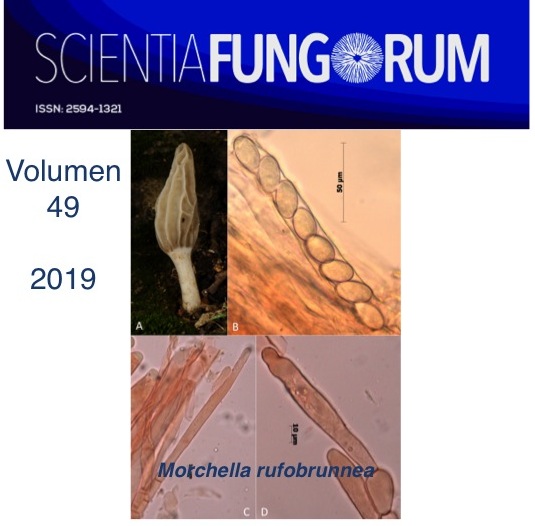Morphological characteristics of wild and cultivated Ganoderma subincrustatum from Sonora, Mexico
DOI:
https://doi.org/10.33885/sf.2019.49.1213Abstract
Background: Ganoderma is a complex genus with high morphological variability. Ganoderma subincrustatum is a common parasite and saprophytic species, and its circumscription is doubtful for some authors. The aim of this study was to analyze the morphological variability of wild and cultivated specimens of G. subincrustatum.
Methods: Ganoderma subincrustatum strain was isolated from a peach orchard in La Costa de Hermosillo, Sonora. The strain was cultivated on vineyard pruning wastes under low and high illumination. Wild and cultivated basidiomata were macro and microscopically characterized and compared.
Results and conclusions: Ganoderma subincrustatum was recorded for the first time from Sonoran mycobiota. Basidiomata color, size and shape were different between wild and cultivated under low and high illumination. High lux condition caused antler shape fruiting bodies. Wild and cultivated specimens showed the same type of context, similar shape of pileipellis cells and basidiospores, but basidiospores were larger in wild specimens.
Downloads
Downloads
Additional Files
Published
How to Cite
Issue
Section
License
Copyright notice
Open access policy
The authors who publish in this journal accept the following conditions:
In accordance with copyright laws, Scientia Fungorum recognizes and respects the authors’ moral rights, as well as the ownership of property rights, which will be transferred to the journal for dissemination in open access. Scientia Fungorum does not charge for submission and processing of articles for publication.
All the texts published by Scientia Fungorum –with no exception– are distributed under a Creative Commons License Attribution-NonCommercial-ShareAlike 4.0 International (CC BY-NC-SA 4.0), which allows third parties to use the publication as long as the work’s authorship and its first publication in this journal are mentioned.
The authors can enter into independent and additional contractual agreements for the nonexclusive distribution of the version of the article published in Scientia Fungorum (for example include it into an institutional repository or publish it in a book) as long as it is clearly and explicitly indicated that the work was published for the first time in Scientia Fungorum.
For all the above, the authors shall send the form of Letter-transfer of Property Rights for the first publication duly filled in and signed by the author(s). This form must be sent as a complementary file.
This work is licensed under a Creative Commons Attribution-NonCommercial-ShareAlike 4.0 International license (CC-By-NC-SA 4.0).



